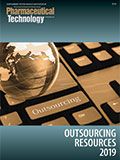News
Article
Pharmaceutical Technology
Ensuring Manufacturing of HPAPIs Under Safe Conditions
Author(s):
Pharmaceutical Technology spoke with Anil Kane, executive director, global science and technology, pharmaceutical development services, at Thermo Fisher Scientific about the industry’s need for more capacity in the manufacture of highly potent APIs.
Pharmaceutical Technology spoke with Anil Kane, executive director, global science and technology, pharmaceutical development services, at Thermo Fisher Scientific about the industry’s need for more capacity in the manufacture of highly potent APIs (HPAPIs) and how contract development and manufacturing companies (CDMOs) can ensure they are developing and manufacturing HPAPIs safely.
PharmTech: In your presentation at CPhI North America 2019, one of the questions from the audience was about capacity challenges for HPAPIs. Can you talk a little bit about that?
Kane: The question that came up from the talk was about capacity and having access to contained equipment, facilities, and infrastructure in the industry to support manufacturing. In my opinion, there is capacity [for development-scale and commercial-scale], but of course the infrastructure is limited, so it’s all about planning and scheduling. The contained pieces of equipment infrastructure to handle highly potent compounds is not available at many places. There are a few CDMOs that can offer a wide spectrum of contained process trains for manufacturing drug products. At Thermo Fisher, we have continued to monitor the demand for HP compounds both on the API side and the drug product side and are planning ahead to invest into contained equipment to be able to support the pharmaceutical industry.
If clients see the need to handle a specific compound in a certain contained manner, it is good to talk early [and] plan ahead, simply because some of the newer investment and contained equipment also has a long lead time. So, even if we start discussing the need, there is a lead time for the manufacturer/vendor to make this equipment and then to qualify and bring it up and running for the actual use for manufacturing. Again, this is beyond the existing equipment infrastructure and capacity, if there is a special need. There is always the possibility to discuss in partnering on investment, co-investment, and different business models that have been successful within Thermo Fisher, and I’m sure elsewhere as well. The point being [is to plan] ahead and make sure we have the right capacity at the right time, because no customer will like to wait or has the time to wait for 6, 9, 12, or in some cases 18 months to have the infrastructure up and ready, the same with equipment, whether its small scale or commercial scale.
For commercial scale, I would say there is always that time for planning, but for early phase, speed is of the essence to confirm proof of concept and proof of efficacy where only clinical results are key to understand the potential that a molecule has to offer.
PharmTech: Has Thermo had some recent expansions in this area?
Kane: Yes, absolutely. In the oral solids area, where the risk of containment of HP products is higher, we have continued to invest in the infrastructure like contained process trains (e.g., contained encapsulators, contained tablet presses, contained roller compactors, etc.). In the past two to five years, we have continued to invest at several of our facilities across the network. We have also seen an increase in highly potent compounds on the injectables side; however, on the injectables side, the risk is rather less because it is in a liquid format and everything is sterile and contained, so the challenges are less in terms of having multiple process trains in injectables.
PharmTech: Are these equipment installations new technology to handle HP or are you adapting existing?
Kane: It’s more adapting the existing equipment to have contained solutions to prevent the exposure to personnel operators. It takes a little more time to set up this equipment because the access to such equipment is limited to the purpose they are built, but they do provide protection to the operator from a HPAPI handling perspective.
PharmTech: Do you see any emerging technologies or automation to further separate the person from the process?
Kane: Oh absolutely. Continuous manufacturing is a great solution; however, this comes into interest for the pharmaceutical industry later in the development chain or beyond clinical proof of concept. In continuous processing, everything is a closed loop. There is no operator intervention or a break in the process. There is no potential for exposure between multiple unit processes, so that is one solution. However, there are limitations. Not every product or process can be manufactured under continuous processing based on the stage of the project, the type of the project, etc. The other solution we have adopted for several years now for HPAPIs is vacuum transfer systems between unit processes. This is not new, but not very common as well because it takes time to qualify and validate such processes where you have a continuous transfer between the unit batch process equipment, and this then prevents any intervention by the operator or potential for exposure. The material characterization and properties, the process needs to be developed and validated to suit such vacuum transfers to ensure product quality, but such development work can be planned and done up front. Softgel dosage form is another drug delivery solution for HPAPIs, and we at Thermo Fisher have had success in containment of potent solids in switching from oral solid dosage forms to a softgel.
Article Details
Pharmaceutical Technology
Supplement: Outsourcing Resources
August 2019
Pages: s9
Citation
When referring to this article, please cite it as R. Peters “Ensuring Manufacturing of HPAPIs Under Safe Conditions," Pharmaceutical Technology Outsourcing Resources Supplement (August 2019).
Newsletter
Get the essential updates shaping the future of pharma manufacturing and compliance—subscribe today to Pharmaceutical Technology and never miss a breakthrough.






